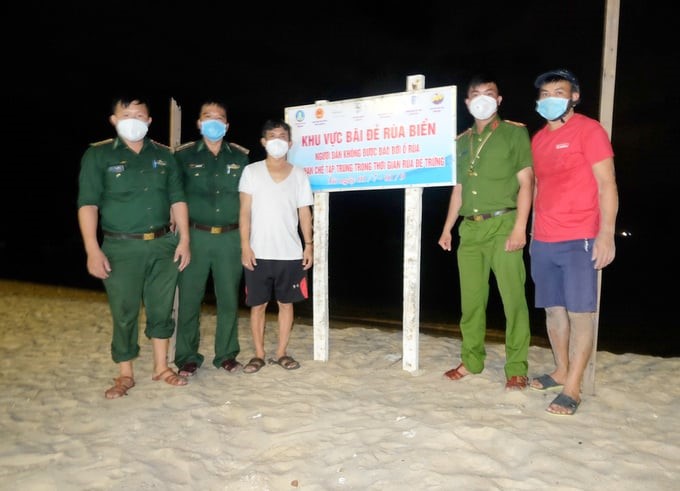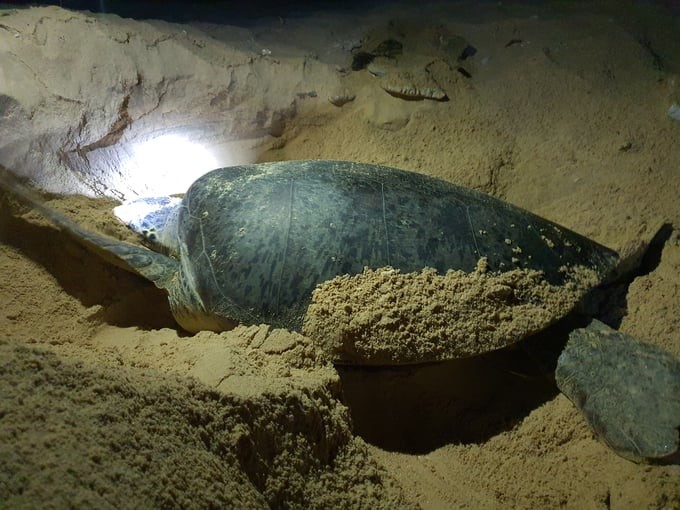December 2, 2025 | 08:59 GMT +7
December 2, 2025 | 08:59 GMT +7
Hotline: 0913.378.918
December 2, 2025 | 08:59 GMT +7
Hotline: 0913.378.918
Binh Dinh is a locality that has done well in protecting sea turtles over the past 15 years. According to the Binh Dinh Sub-Department of Fisheries, in 2007, this province's functional sector, under the consultation of Ms. Gail Berbie, a volunteer from New Zealand’s VSA Organization, implemented a survey on the spawning grounds of sea turtles in Nhon Hai commune (Quy Nhon city). As a result, a turtle spawning ground was discovered at Hon Kho (Nhon Hai commune). Sea turtles laying in Nhon Hai are green turtles, whose scientific name is Chelonia mydas.
Since then, to preserve sea turtles, Binh Dinh's agriculture sector has coordinated with the International Union for Conservation of Nature (IUCN) to mobilize local fishermen to protect and preserve spawning grounds for sea turtles.

A sea turtle protection volunteer and an official of the Binh Dinh Sub-Department of Fisheries released baby turtles back to the sea in 2013. Photo: V.D.T.
Mr. Nguyen Ton Xuan Sang, Director of Nhon Hai Tourism and Fisheries Service Cooperative (Quy Nhon city, Binh Dinh), member of the Community Group to protect aquatic resources and a volunteer to protect local sea turtles, said: Every year, from June to August on the lunar calendar, is the spawning season of sea turtles. Previously, when Nhon Hai fishing village was still a coastal commune with deserted sand banks, sea turtles chose this place as a place to give birth.
But since Nhon Hai fishermen have strongly developed near-shore fishing, human and boat activities have taken away the desolation of these sand banks, meaning sea turtles have lost their spawning grounds. From then on, when the spawning season comes, the mother turtles flock to Hon Kho, an island located separately from the residential area of Nhon Hai commune, to give birth in peace.
To preserve sea turtles, the Binh Dinh fisheries industry has coordinated with IUCN to mobilize local fishermen to protect and preserve spawning grounds for sea turtles. Besides, the Binh Dinh fisheries industry also regularly organizes seminars and training around the content of sea turtle conservation for officials, fishermen in coastal localities, business people and traders of aquatic products, and related businesses.
"The efforts of the functional sector, the local government, and related branches have touched people's hearts. Coastal people not only raised their awareness of protecting sea turtles by no longer catching turtles for sale as before but also knew how to protect turtle eggs. They no longer took eggs home to boil, eat, or sell, but every time they discovered a clutch of eggs, they immediately reported it to the functional sector or local government for protection. Even many people, when encountering sea turtles being sold in rural markets, immediately spend money to buy them and then hand them over to the functional sector," said Mr. Tran Van Vinh, Deputy Director of Binh Dinh Sub-Department of Fisheries.

Sea turtle protection volunteer group of Nhon Hai commune (Quy Nhon city, Binh Dinh) Photo: V.D.T.
In mid-2023, Binh Dinh Sub-Department of Fisheries coordinated with the People's Committee of Nhon Hai commune (Quy Nhon city) and two businesses operating in the tourism field, namely Avani Quy Nhon Resort and Anantara Quy Nhon Villas, to organize a communication campaign on preserving sea turtle spawning grounds in the Con Cape beach area (Nhon Hai commune), with a large number of local people joining.
According to Mr. Tran Van Vinh, Nhon Hai Peninsula commune is the only place in Binh Dinh where sea turtles come to the beach to lay eggs. Sea turtle conservation activities began in Nhon Hai commune in 2007. In 2010, the Binh Dinh Sub-Department of Fisheries implemented community-based conservation activities for sea turtle spawning grounds, established a volunteer group to protect sea turtle spawning grounds, and implemented many dissemination activities to raise public awareness.
Thanks to the above-mentioned activities, awareness among the Binh Dinh coastal fishermen community, especially people in Nhon Hai commune (Quy Nhon city), of protecting aquatic resources, especially sea turtle conservation, has obviously increased. However, the current sea turtle conservation in Nhon Hai commune faces a big challenge, which is that economic and residential projects are causing the risk of gradually losing sea turtle spawning grounds.

Sea turtles dig sand to make nests to protect their eggs. Photo: V.D.T.
“Therefore, preserving spawning grounds for sea turtles is very necessary. To effectively carry out this work, we need to further promote forms of communication and spread messages widely in the community about the importance of preserving sea turtles and protecting the environment and marine ecosystem," said Mr. Tran Van Vinh, Deputy Director of the Binh Dinh Sub-Department of Fisheries.
In 2022, the Quy Nhon City People's Committee issued a document agreeing on the temporary planning project for Nhon Hai commune beach. Accordingly, the total planning area along the beach located on the water surface is 14.67 hectares, divided into three areas: the area for anchoring boats, fishing net tools, and baskets; the area for beach swimming and tourist services; and the area for turtle spawning grounds located at Con Cape in Hai Dong village (Nhon Hai commune). Of which, the area for turtle spawning grounds has an area of more than 9,856 m2. All swimming, playing, and entertainment activities are strictly prohibited in this area, which only serves turtles laying eggs.
Translated by Huyen Vu Thu

(VAN) The Institute of Agricultural Sciences for Southern Vietnam (IAS) marked its 100th anniversary in Ho Chi Minh City, celebrating a century of growth as a leading institute contributing significantly to Viet Nam’s agricultural development.

(VAN) An increasing number of livestock farms are using biogas generators to create a source of renewable electricity, helping to save costs and mitigate environmental pollution.

(VAN) Small changes in rice cultivation, from irrigation methods and straw collection to input management, are paving a new way for Vietnam's agriculture in the journey toward emission reduction.

(VAN) With the project of converting biogas into renewable electricity, Australia is both helping pig farms reduce their energy costs by up to 25% and contributing to environmental protection.
![Hue aims for Net Zero: [1] Initial steps from green transportation](https://t.ex-cdn.com/nongnghiepmoitruong.vn/608w/files/huytd/2025/11/28/0853-anh-6-giao-thong-xanh-hue-094717_940-153724.jpg)
(VAN) For sustainable development, Hue City is implementing many solutions to promote green transportation, which is an important initial step on the journey to building a Net Zero Hue.

(VAN) Nghe An Province, one of the localities with the largest forest area in Vietnam, is set to gain significant benefits from the implementation of forest carbon credit payments.

(VAN) Circular agriculture helps Mekong Delta farmers cut greenhouse gas emissions while boosting incomes through efficient reuse of agricultural by-products.